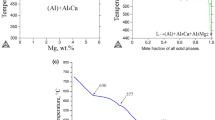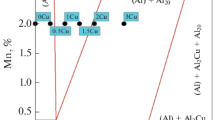Conclusions
-
1.
The optimal combination of fracture toughness, fatigue limit, and strength characteristics of D16 alloys can be obtained from semifinished products with a primarily unrecrystallized structure and with the copper and magnesium concentrations near the lower limit, and possibly by reducing iron and silicon impurities.
-
2.
The amount of manganese should be minimal but sufficient to obtain a preferentially unrecrystallized structure under given conditions of hot deformation. The deformation during straightening should be held to the minimum within the limits of the given OST.
Similar content being viewed by others

Literature cited
L. Mondolfo, Aluminium Alloys, Structure and Properties, Butterworths (1976), p. 639.
A. F. Semenov and O. A. Setyukov, "Excess intermetallic compounds in alloy D1," Tekh. Legkikh Splavov, No. 6, 9 (1972).
H. Phillips, Annotated Equilibrium Diagrams of Some Aluminium Alloy Systems (1959), No. 25.
G. Lutjering, H. Pöker, and D. Munz, The Microstructure and Design of alloys. Proc. Third Int. Conf. on Strength of Metals and Alloys, Cambridge, England (1973), Vol. 1, p. 87.
Additional information
Translated from Metallovedenie i Termicheskaya Obrabotka Metallov, No. 3, pp. 33–36, March, 1982.
Rights and permissions
About this article
Cite this article
Leshchiner, L.N., Fedorenko, T.P. Effect of composition and structure on the properties of wrought aluminum alloys of the D16 type. Met Sci Heat Treat 24, 187–190 (1982). https://doi.org/10.1007/BF01166850
Issue Date:
DOI: https://doi.org/10.1007/BF01166850



